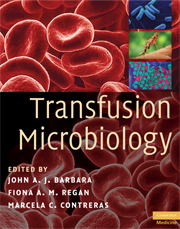Book contents
- Frontmatter
- Contents
- List of contributors
- Foreword
- Preface
- Acknowledgements
- Glossary
- Introduction: Transfusion-transmitted infections, then and now
- Section 1 Agents
- Section 2 Selection and testing
- Section 3 Surveillance, risk and regulation
- 21 Serious hazards of transfusion (SHOT); haemovigilance
- 22 Investigation of post-transfusion infection
- 23 Notification of donors with significant microbiological test results
- 24 Researching the natural history of transfusion-transmitted infections: the UK hepatitis C (HCV) national register
- 25 How to assess risk: prospective studies and calculations
- 26 Risk management
- 27 The regulatory environment in Europe
- 28 Blood safety in developing countries
- Index
- Plate section
- References
21 - Serious hazards of transfusion (SHOT); haemovigilance
from Section 3 - Surveillance, risk and regulation
Published online by Cambridge University Press: 12 January 2010
- Frontmatter
- Contents
- List of contributors
- Foreword
- Preface
- Acknowledgements
- Glossary
- Introduction: Transfusion-transmitted infections, then and now
- Section 1 Agents
- Section 2 Selection and testing
- Section 3 Surveillance, risk and regulation
- 21 Serious hazards of transfusion (SHOT); haemovigilance
- 22 Investigation of post-transfusion infection
- 23 Notification of donors with significant microbiological test results
- 24 Researching the natural history of transfusion-transmitted infections: the UK hepatitis C (HCV) national register
- 25 How to assess risk: prospective studies and calculations
- 26 Risk management
- 27 The regulatory environment in Europe
- 28 Blood safety in developing countries
- Index
- Plate section
- References
Summary
The Serious Hazards of Transfusion scheme (SHOT), is the UK's approach to the surveillance of complications associated with the transfusion of blood and blood components. It was established as part of the UK's response to a European Commission (EC) resolution in 1995 on ‘Blood safety and self-sufficiency in the Community’ (Council Resolution, 1995). This identified that one of the main activities needed to improve public confidence in the safety of the blood supply was the development of a haemovigilance system ‘based on the existing networks for the collection of data related to the blood transfusion safety chain’. Certain aspects of haemovigilance are now a requirement in Europe, as specified in the EU Directive ‘Setting standards of quality and safety for the collection, testing, processing, storage and distribution of human blood and blood components’ (EU Directive, 2002). These requirements are now adopted in UK law (The Blood Safety and Quality Regulations, 2005).
What is haemovigilance?
Haemovigilance is a broad term which is defined in Council of Europe Guidelines as comprising the detection, gathering and analysis of untoward and unexpected effects of blood transfusion (Council of Europe, 2005). These may contribute to the safety of blood transfusion by:
Providing the medical community with a reliable source of information about untoward effects of blood transfusion.
Indicating corrective measures required to prevent the recurrence of some accidents or dysfunctions in the transfusion process.
Warning hospitals and blood transfusion services about adverse events that could involve more individuals than a single recipient.
Its scope may cover the entire transfusion process, from collection of the donation to transfusion of the recipient and follow-up of the transfusion.
- Type
- Chapter
- Information
- Transfusion Microbiology , pp. 305 - 310Publisher: Cambridge University PressPrint publication year: 2008



